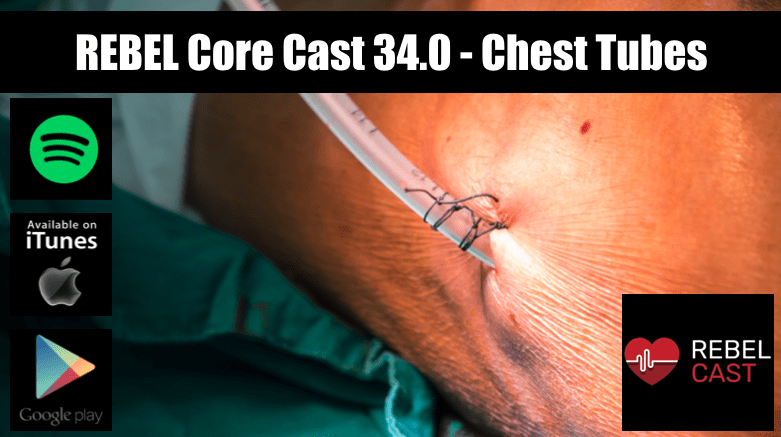
- Small to Moderate Size Pneumothorax – consider managing conservatively with observation (need to make sure consulting services on same page)
- Needle aspiration for spontaneous pneumothorax recommend by British Thoracic and European Respiratory Societies
- 1 in 5 patients requiring a chest tube will suffer complications – many are iatrogenic in nature. Practice procedure via simulation
- Chest tubes placed for traumatic pneumothoraces should get prophylactic antibiotics
- When deciding on treatment strategy, discuss with your consultants and make sure you have institutional buy-in.
REBEL Core Cast 34.0 – Chest Tubes
Spontaneous Pneumothorax Management
- Traditional teaching was to put a small-bore chest tube and admit the patient
- NEJM study offers evidence for conservative management and observation: Conservative versus Interventional Treatment for Spontaneous Pneumothorax
- Randomized trial
- Patients were randomized to either observation or invention with small bore (<12 french) chest tube
-
- Repeat CXR done at 1 hour
- Re-expansion of lung and no air leak, tube was clamped and repeat CXR at 4 hours
- No Recurrent of PTX, chest tube pulled and patient discharged
- Patient reassessed between 24-72 hours and had follow up visits with repeat car at 2, 4 and 8 weeks
- Authors found that patients with primary spontaneous pneumothorax observation was not inferior to intervention
- Observation group did take nearly twice as long to achieve radiographic resolution (16d v 30d) – non-patient centered outcome
-
Symptom resolution similar and observation group had less adverse events.
- Less recurrence, less days hospitalized, less days of missed work, less procedures and less hospital revisits
Need Aspiration
- Typically performed at 2nd Intercostal space in the midclavicular line. However please review the last core cast about why needle decompression in this area is not ideal.
-
Instead, perform this procedure at the 4th or 5th intercostal space in anterior axillary line
- Easier to identify, less critical structures and thinner area
-
Perform using US guidance – check landmarks to be sure going into the right area
- Use 8cm 14 gauge angiocath and attach to 3 way stop cock, attach to either 50cc syringe or cavity drainage tray.
-
No robust literature on needle aspiration
-
2017 Cochrane review found that tube thoracostomy outperformed need aspiration in immediate success rate
- No difference in early failure rate, one-year success rate and hospitalization rate
- Needle aspiration associated with less adverse events
-
2017 Cochrane review found that tube thoracostomy outperformed need aspiration in immediate success rate
Size Matters
- Simple pneumo with just air in pleural space – no blood / pus / effusion than 14 french pigtail catheter is appropriate
- American College of Chest Physicians (ACCP) recommends stable patients with pneumothorax get small bore and the unstable patient gets a small to moderate-sized chest tube.
-
ACCP tube classifications
- Small-bore 7-14 french
- Moderate 16-22 french
- Large >24 french
Hemothorax
- More viscous fluid like blood or pus requires a larger tube for appropriate drainage.
- Rate of drainage is directly proportional to diameter of the tube
- ATLS recommends 28-32 french chest tube for traumatic hemo-pneumo thorax
Chest Tube Complications
-
Early complications
-
Iatrogenic – insertional complication if tube placed into adjacent structure.
- Lung most common structure damaged
-
Positional – tube within cavity but the position is not optimal
- Difficult to adjust – one sterile field is broken chest tube cannot be advanced
-
Iatrogenic – insertional complication if tube placed into adjacent structure.
-
Late Complications
- Chest tube removal leading to reaccumulation of pneumothorax
- Infection – cellulitis, empyema and pneumonia
- Malfunction – persistent air leak because of bronchopulmonary fistula
- Obstruction – occlusion with blood or pus
Antibiotics
- Primary spontaneous pneumothorax – no good evidence for routine use of antibiotic prophylaxis
-
Chest tube s/p chest trauma – recommendation for antibiotics.
- Meta-analysis showed antibiotics reduced the risk of empyema and pneumonia
More on the Topic
- REBEL EM: Spontaneous Pneumothorax: Stand There and Do Nothing?
-
REBEL EM: Ultrasound Detection Pneumothorax
-
Taming the SRU: Needle Thoracostomy
- REBEL EM: What is the best anatomical position for needle thoracostomy
- EM Docs: Pneumothorax
Shownotes Written By: Miguel Reyes, MD (Twitter: @miguel_reyesMD)
Post Peer Reviewed By: Salim R. Rezaie, MD (Twitter: @srrezaie)
The post REBEL Core Cast 34.0 – Chest Tubes appeared first on REBEL EM - Emergency Medicine Blog.

